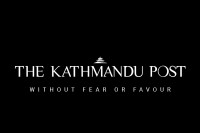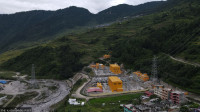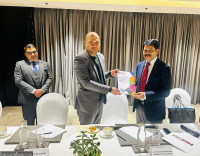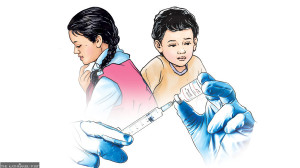Money
US-Bangla ordered to pay full damages for 2018 fatal crash
Kathmandu court cites gross negligence, wilful misconduct. 17 families win Nepal’s first air crash compensation case.
Sangam Prasain
In a landmark verdict, the Kathmandu District Court has ordered Dhaka-based US-Bangla Airlines to pay full compensation to the families of victims who died in the crash of Flight 211 in March 2018 while landing at Kathmandu airport, an accident that claimed 51 lives out of the 71 onboard.
In a settlement that excludes the $20,000 insurance payout to each family, the court has directed the airline to pay a total of $2.74 million, or Rs378.60 million, to the 17 families affected by the tragedy.
This marks a legal milestone—the first time in Nepal’s aviation history that families of air crash victims have won a case of this magnitude. Nepal has witnessed 70 air crashes over the past seven decades, with approximately 964 fatalities, most attributed to gross negligence.
Yet no airlines had been held accountable—until now.
Though US-Bangla Airlines retains the right to appeal the High Court and Supreme Court verdict, Sunday’s decision sets a significant precedent. It allows passengers or their families to file lawsuits and claim unlimited liability from airlines in cases of wilful misconduct or gross negligence.
“The full text of the verdict may take some time to be released,” said Deepak Kumar Shrestha, information officer at the Kathmandu District Court.
The ruling was issued by Judge Diwakar Bhatta, who presided over the case filed by the families of 16 deceased passengers and one survivor.
The tragic crash occurred on March 12, 2018, when a scheduled US-Bangla flight from Dhaka to Kathmandu went off course while landing at Tribhuvan International Airport. The 76-seater Bombardier Q400 burst into flames on impact, killing 51 people. Among the dead were 22 Nepalis, 28 Bangladeshis, and one Chinese national. The incident remains the deadliest aviation disaster involving a Bangladeshi airline and the most fatal involving a Bombardier Dash 8 Q400.
Following a seven-year-long legal battle, the court concluded that the airline bore “gross negligence” for failing to fly properly with an airworthy aircraft.
Court documents obtained by the Post show that each of the seven MBBS students—Ashna Shakya, Anjila Shrestha, Meeli Maharjan, Neega Maharjan, Princy Dhami, Sanjaya Maharjan, and Shreya Jha—has been awarded $170,382 or Rs23.4 million.
Their families filed the lawsuit on July 31, 2019, citing wrongful death and seeking unlimited compensation. The settlement amount excludes the $20,000 insurance payment.
Another set of six MBBS students—Shweta Thapa, Sanjay Poudel, Purnima Lohani, Angila Baral, Charu Baral, and Saruna Shrestha—each has been awarded $179,418 or Rs24.73 million, excluding insurance.
The court also ruled that US-Bangla must pay $107,170 or Rs14.74 million to the family of Prasanna Pandey, an employee of Himalaya Airlines who was among the victims.
Compensation for Dr Bal Krishna Thapa, a neurosurgeon, was set at $277,548 or Rs36.74 million.
For Gyani Kumari Gurung, a 67-year-old nurse who died in the crash, the court determined compensation at $45,301 or Rs6.2 million.
Survivor Dr Samira Byanjankar, who sustained serious injuries, was awarded $44,290 or Rs6.1 million. Again, all of these figures exclude the standard $20,000 insurance amount.
At the time of the crash, US-Bangla Airlines had insurance coverage of $107 million. This included $7 million for the aircraft and $100 million for passenger liabilities, underwritten by two local Bangladeshi insurers—Sena Kalyan Insurance Company and Sadharan Bima Corporation.
Initially, many families considered avoiding prolonged litigation by accepting the airline’s early settlement offer of $50,000 per victim. However, they rejected the offer, seeking legal action to secure what they viewed as rightful and just compensation.
According to court officials, although accident investigation reports prepared under ICAO’s Annex 13 are not meant to assign legal blame and cannot be used as primary legal evidence, the full verdict will elaborate on how the court arrived at the compensation amounts and how it established liability.
The ruling cited financial, physical, human, and psychological factors while determining compensation. It concluded that the airline’s wilful misconduct and gross negligence—especially the pilot’s questionable mental state—led to the crash of an otherwise airworthy aircraft.
The court decided based on the Warsaw Convention of 1929 and its 1955 Hague Protocol amendment. These treaties govern the liability of airlines in international travel. The Hague Protocol, in particular, increased liability limits for air carriers. The court did not apply the newer Montreal Convention, as neither Nepal nor Bangladesh was a party to it at the time of the crash.
The Montreal Convention, adopted in 1999, replaced the Warsaw system and provides a more modern and uniform framework for international airline liability. Nepal only adopted the Montreal Convention later—on December 15, 2018—nine months after the crash.
Under the revised Montreal Convention, as of October 2024, the compensation for death or bodily injury increased from 128,821 to 151,880 Special Drawing Rights (SDRs)—about $216,285. When first enacted in 2003, the limit was 100,000 SDRs—about $142,405.
For families, the fight was long and emotionally draining.
“We finally got the verdict after seven years of waiting. It’s really painful to have to fight for your child’s rights after their death,” said Bidhur Man Shrestha, father of Angila Shrestha, one of the MBBS students. Shrestha had demanded $2.7 million in unlimited compensation. He recalled that the airline had initially offered a mere $50,000.
“We are still not happy with the compensation. But at least, we won the case. We got justice.”
Advocate Amrit Kharel, who filed the initial case on behalf of the families of seven deceased students, said that US-Bangla Airlines had misled the victims’ families by equating the insurance payout with full compensation.
“In reality, that insurance amount is covered by passengers when they purchase tickets—it’s not something airlines pay out of their own pocket.”
“Insurance and compensation are two distinct legal components,” Kharel explained. In cases involving proven negligence or recklessness, compensation ensures a form of justice when insurance alone cannot adequately cover losses.
“The airline is liable to pay full compensation due to its willful misconduct and gross negligence. This is a historic win—the first of its kind in Nepal’s aviation history where passengers have prevailed. It’s a victory for human rights,” Kharel said.
He described the ruling as a landmark verdict that could change how airline accountability is perceived. “It sends a powerful message to the global community: Nepal, too, offers legal remedies in cases of passenger deaths.”
Court officials echoed this sentiment, saying the ruling allows victims of air crashes to seek unlimited compensation, something rarely seen in Nepal.
They noted that the risk of being held liable for substantial compensation could push airline operators to adopt more stringent safety measures, invest in better training, and enforce robust maintenance and operational protocols.




 9.12°C Kathmandu
9.12°C Kathmandu













%20(1).jpg&w=300&height=200)
